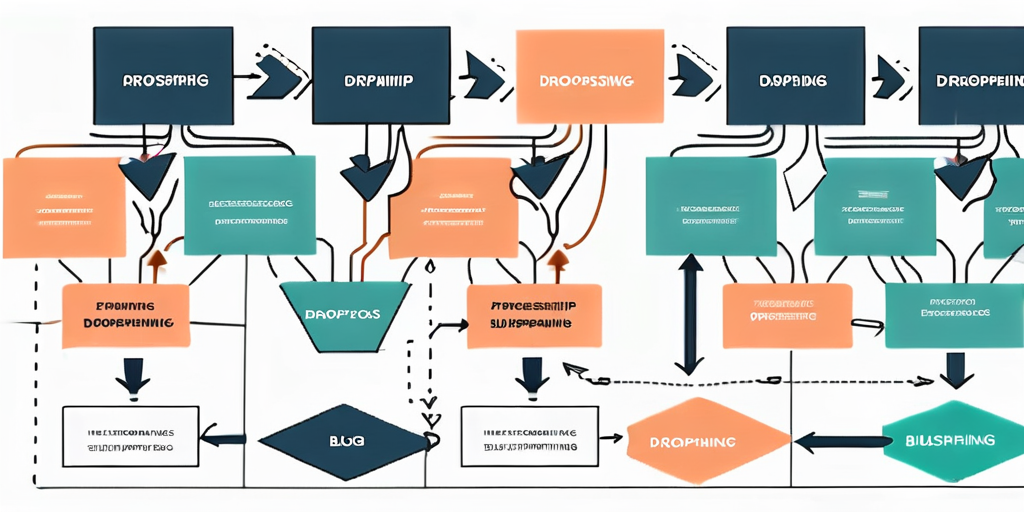In the fast-paced world of e-commerce, dropshipping has emerged as a popular business model for aspiring entrepreneurs. This comprehensive guide aims to provide a clear understanding of what dropshipping is, its benefits, challenges, and how it works. Whether you are new to the concept or looking to expand your existing knowledge, this article will serve as a valuable resource for you.
Understanding the Basics of Dropshipping
Defining Dropshipping
At its core, dropshipping is a business model where sellers do not hold inventory. Instead, they partner with suppliers who fulfill orders directly to customers. This means that the seller does not handle the products physically, as they are shipped directly from the supplier’s warehouse to the end consumer.
Dropshipping has revolutionized the way businesses operate in the e-commerce industry. It has opened up a world of opportunities for entrepreneurs who want to start their own online business without the burden of managing inventory. By eliminating the need for warehousing and shipping, dropshipping allows sellers to focus on what they do best: marketing and customer acquisition.
The Role of Dropshipping in E-commerce
Dropshipping plays a significant role in the ever-growing world of e-commerce. It enables entrepreneurs to start an online business without the need for a large upfront investment in inventory. By leveraging the dropshipping model, sellers can focus on marketing and customer acquisition, leaving the logistics and inventory management to the suppliers.
Moreover, dropshipping has democratized the e-commerce industry, making it accessible to individuals from all walks of life. Whether you’re a stay-at-home parent looking to earn some extra income or a digital nomad seeking financial freedom, dropshipping offers a flexible and scalable business model that can be tailored to your needs.
Key Components of a Dropshipping Business
When starting a dropshipping business, several key components need to be in place for success. These include identifying a profitable niche, selecting products, finding reliable suppliers, setting up an online store, and implementing effective marketing strategies. Each component is crucial and requires careful consideration to ensure a smooth operation.
Identifying a profitable niche is the foundation of a successful dropshipping business. It involves conducting market research to identify trends, demand, and competition. By finding a niche with high demand and low competition, sellers can position themselves for success.
Once a niche is chosen, selecting the right products is essential. Sellers need to curate a product catalog that aligns with their target audience’s needs and preferences. This involves sourcing products from reliable suppliers who can consistently deliver high-quality items.
Setting up an online store is the next step in building a dropshipping business. Sellers can choose from various e-commerce platforms that offer user-friendly interfaces and customizable templates. It’s important to create a visually appealing and user-friendly website that instills trust and encourages conversions.
Lastly, effective marketing strategies are crucial for driving traffic and generating sales. This can include search engine optimization (SEO), social media marketing, influencer collaborations, and email marketing. By implementing a comprehensive marketing plan, sellers can reach their target audience and build a loyal customer base.
The Benefits and Challenges of Dropshipping
Advantages of Starting a Dropshipping Business
One of the primary advantages of dropshipping is the low upfront costs. Unlike traditional retail models, where significant investments are required for inventory, dropshipping allows entrepreneurs to launch their business with minimal financial risk. This means that individuals with limited capital can still enter the market and pursue their entrepreneurial dreams.

Additionally, dropshipping offers the freedom to work from anywhere, as long as there is an internet connection. This flexibility is especially attractive for those seeking location independence. Imagine being able to run your business while sipping a cup of coffee at a cozy caf�� in Paris or lounging on a tropical beach in Bali. With dropshipping, the world truly becomes your office.
Furthermore, dropshipping provides access to a wide range of products without the need for extensive storage space. This allows sellers to experiment with different niches and product offerings, constantly adapting to market trends and consumer demands. Whether you want to sell trendy fashion accessories or niche pet products, dropshipping provides the platform to explore various markets and find your profitable niche.
Potential Drawbacks and Risks in Dropshipping
While dropshipping offers numerous advantages, it is not without its challenges. One common hurdle is increased competition. As dropshipping becomes more popular, more sellers enter the market, making it essential to find ways to differentiate your business effectively. This means that you need to invest time and effort into building a strong brand, providing exceptional customer service, and offering unique products that stand out from the crowd.
Another potential risk is relying on suppliers for product fulfillment. It’s crucial to partner with reliable suppliers to ensure timely order processing and shipping. Inconsistent product quality, delayed shipments, or limited stock can lead to negative customer experiences, potentially harming your reputation and business growth. Therefore, it is vital to thoroughly research and vet your suppliers, establishing strong relationships built on trust and reliability.
Furthermore, as your business grows, managing inventory and logistics can become more complex. It’s important to implement efficient systems and processes to handle the increasing volume of orders and ensure smooth operations. This may involve investing in inventory management software or outsourcing certain tasks to third-party fulfillment centers.
How Dropshipping Works: A Step-by-Step Process
Choosing a Niche and Products for Dropshipping
The first step in starting a dropshipping business is identifying a profitable niche. A niche is a specific segment of the market that caters to a particular set of customers. Conduct thorough market research to pinpoint gaps and opportunities within your chosen niche. This research involves analyzing trends, studying customer behavior, and understanding the competition. By gaining a deep understanding of your target audience, you can better tailor your product selection to meet their needs and preferences.

Once you have a niche in mind, select products that align with market demand and consumer preferences. Consider factors such as product quality, uniqueness, and pricing. It’s important to strike a balance between offering products that are in high demand and differentiating yourself from competitors. By offering unique products or providing a better customer experience, you can stand out in a crowded market.
Finding Reliable Dropshipping Suppliers
The success of your dropshipping business heavily relies on the reliability of your suppliers. Look for suppliers who offer competitive pricing, sufficient inventory, and excellent customer service. To find reliable suppliers, consider attending trade shows, searching online directories, and reaching out to manufacturers directly. It’s crucial to establish strong relationships with your suppliers to ensure smooth order fulfillment and timely delivery to your customers.
In addition to reliability, consider the location of your suppliers. Choosing suppliers that are geographically closer to your target market can help reduce shipping costs and delivery times. This can lead to improved customer satisfaction and repeat business. Furthermore, consider working with multiple suppliers to diversify your product offerings and mitigate the risk of relying on a single supplier.
Setting Up Your Dropshipping Store
Creating an online store is a critical step in establishing your dropshipping business. Choose a user-friendly e-commerce platform and design a visually appealing website that reflects your brand. Consider the overall user experience, ensuring that your website is easy to navigate and mobile-friendly. Optimize your product listings with engaging descriptions and high-quality images to attract potential customers. Additionally, ensure that your store offers a smooth checkout process and secure payment options to enhance customer trust.
When setting up your dropshipping store, it’s important to consider the importance of branding. Develop a strong brand identity that resonates with your target audience. This includes creating a compelling logo, choosing a consistent color scheme, and crafting a unique brand voice. By building a strong brand, you can differentiate yourself from competitors and build customer loyalty.
Marketing Your Dropshipping Business
To drive traffic and generate sales, effective marketing strategies are essential. Focus on search engine optimization (SEO) to increase your website’s visibility on search engines. Conduct keyword research to identify relevant search terms that your target audience is likely to use. Incorporate these keywords into your website content, product descriptions, and blog posts to improve your search engine rankings.
Utilize social media platforms to engage with your target audience and promote your products. Develop a content strategy that includes a mix of informative and engaging posts, product showcases, and customer testimonials. Encourage user-generated content and leverage social media influencers to expand your reach and attract potential customers.
Email marketing can also be a valuable tool to attract potential customers and build long-term relationships. Develop a segmented email list and send personalized emails to your subscribers. Offer exclusive discounts, provide helpful tips and advice, and keep your subscribers updated on new product launches and promotions.
By implementing a comprehensive marketing strategy that combines SEO, social media, and email marketing, you can effectively promote your dropshipping business and drive consistent traffic to your online store.
Legal and Ethical Considerations in Dropshipping
Understanding Legal Obligations in Dropshipping
Operating a dropshipping business requires compliance with relevant laws and regulations. Understand the legal obligations related to taxes, consumer protection, intellectual property, and data privacy. Consult with professionals or seek legal advice to ensure that your business operates legally and ethically.

Ethical Practices for a Successful Dropshipping Business
Maintaining ethical practices fosters trust, credibility, and long-term success in dropshipping. Honesty and transparency with customers regarding shipping times, product availability, and return policies build a solid foundation for your business. Additionally, treating suppliers with fairness and respect establishes strong and reliable partnerships.
In conclusion, dropshipping offers an exciting opportunity for aspiring entrepreneurs to venture into the e-commerce world with minimal financial risk. Understanding the basics, benefits, and challenges of dropshipping, as well as the step-by-step process involved, is essential for setting up a successful dropshipping business. By combining thorough research, careful planning, and effective marketing strategies, you can create a thriving dropshipping business in today’s competitive online marketplace.


